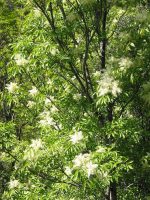 Native to southern Europe and Asia Minor, this deciduous tree is also called manna ash and is a member of the olive family, Oleaceae, that also includes privet, forsythia, and lilac. It grows up to 50′ tall and has a short trunk with smooth, dark gray bark and dark green pinnately compound leaves 5-8″ long with 5-9 leaflets that are ovate to oblong, finely serrated, and 2-3″ long. Terminal and axillary panicles of creamy white, fragrant flowers appear with or after the leaves. The panicles are up to 5″ long and give ways to clusters of 2″ long unattractive winged seed pods called samaras that ripen in the fall and may persist into the winter. The trees are valued for their spring bloom, shade, and were used as ornamental trees until the emerald ash borer became a problem. Fall color ranges from dull yellow to red-purple and is not considered an asset. The sap from the tree has been used medicinally and as a sweetener and anti-caking agent. The genus name, Fraxinus, is the classical Latin name for the plant. The specific epithet, ornus, is of unknown origin and meaning but may be derived from an old word for ashes.
Native to southern Europe and Asia Minor, this deciduous tree is also called manna ash and is a member of the olive family, Oleaceae, that also includes privet, forsythia, and lilac. It grows up to 50′ tall and has a short trunk with smooth, dark gray bark and dark green pinnately compound leaves 5-8″ long with 5-9 leaflets that are ovate to oblong, finely serrated, and 2-3″ long. Terminal and axillary panicles of creamy white, fragrant flowers appear with or after the leaves. The panicles are up to 5″ long and give ways to clusters of 2″ long unattractive winged seed pods called samaras that ripen in the fall and may persist into the winter. The trees are valued for their spring bloom, shade, and were used as ornamental trees until the emerald ash borer became a problem. Fall color ranges from dull yellow to red-purple and is not considered an asset. The sap from the tree has been used medicinally and as a sweetener and anti-caking agent. The genus name, Fraxinus, is the classical Latin name for the plant. The specific epithet, ornus, is of unknown origin and meaning but may be derived from an old word for ashes.
Type: Deciduous flowering tree
Outstanding Feature:Flowers, sap
Form: Rounded
Growth Rate: Slow
Bloom:Panicles of fragrant, creamy white flowers in spring
Size: 15-50′ H x 15-50′ W
Light:Full sun
Soil: Fertile, medium moist, well-drained; somewhat drought tolerant; like cool summers.
Hardiness: Zones 6-9
Care: Control of emerald ash borer is imperative but difficult; fertilize regularly.
Pests and Diseases: Susceptible to emeralds ash borer, lilac borer, carpenter worm, oyster shell scale, leaf miners, fall webworms, ash sawflies, ash leaf curl aphid, fungal leaf spots, powdery mildew, rust, anthracnose, cankers and ash yellows.
Propagation: Seed, grafting
Outstanding Selections: None; not recommended for cultivation due to emerald ash borer.
Photo Credit: Jean-Pol Grandmont Wikipedia